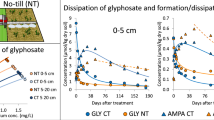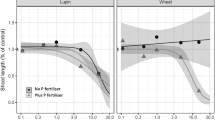Abstract
Translocation of glyphosate (N-(phosphonomethyl)glycine) to plant roots and its impact on detected herbicide residues in sandy loam soil were studied in a glasshouse pot experiment in Finland. Quinoa (Chenopodium quinoa, Willd) plants in two different growing phases (6–8 and 12–14 leaf stages, groups A and B, respectively) were sprayed with non-labelled glyphosate. Bare soil pots were included as controls (group C). Soil surface contamination with glyphosate was prevented in groups A and B but not in group C. Soil samples were collected 1 h, 8 days and 44 or 53 days after the glyphosate applications. Root samples were taken 8 days after the application from group B. After 8 days from the treatment, 4% of the applied glyphosate was detected in soil and about 12% in roots (group B). One and a half months later 12% and 8% of the applied glyphosate (groups A and B, respectively) was detected in soil samples incubated with roots. The main metabolite of glyphosate, aminomethyl phosphonic acid (AMPA), was not found in root samples. Glyphosate fate was simulated with the PEARL 3.0 model. Simulated concentrations in bare soil pots were very close to the observed ones. However, the model lacks a process description for herbicide transport within a plant and, therefore, the observed and simulated glyphosate residues in soil after canopy applications did not correlate. Simulations highlight the importance of the translocation process in glyphosate fate. We conclude that also in field studies part of the detected glyphosate soil residues must originate from plant roots, and translocation process should be included both in leaching assessments and pesticide fate models.



Similar content being viewed by others
References
Alferness PL, Wiebe LA (2001) Determination of glyphosate and aminomethylphosphonic acid in crops by capillary gas chromatography with mass-selective detection: collative study. J AOAC Int 84:823–846
Autio S, Siimes K, Laitinen P, Rämö S, Oinonen S, Eronen L (2004) Adsorption of sugar beet herbicides into Finnish soils. Chemosphere 55:215–226
Börjesson E, Torstensson L (2000) New methods for determination of glyphosate and (aminomethyl)phosphonic acid in water and soil. J Chromatogr A 886:207–216
Coupland D, Caseley JC (1979) Presence of 14C activity in root exudates and guttation fluid from Agrypyron repens treated with 14C-labeled glyphosate. New Phytol 83:17–22
de Jonge H, de Jonge LW, Jacobsen OH (2000) [C-14] glyphosate transport in undisturbed topsoil columns. Pest Manag Sci 56:909–915
Eberbach P, Bowmer K (1995) Conversion of 14C-glyphosate to carbon dioxide by alligator weed. J Aquat Plant Manage 33:27–29
Feng PCC, Pratley JE, Bohn JA (1999) Resistance to glyphosate in Lolium rigidum. II. Uptake, translocation, and metabolism. Weed Sci 47:412–415
FOCUS 2000 FOCUS groundwater scenarios in the EU review of active substances, Report of the FOCUS Groundwater Scenarios Workgroup. EC Document Reference Sanco/321/2000 rev. 2. p202
Geiger DR, Shieh W-J, Fuchs MA (1999) Causes of self-limited translocation of glyphosate in Beta vulgaris plants. Pestic Biochem Physiol 64:124–133
Giesy JP, Dobson S, Solomon KR (2000) Ecotoxicological risk assessment for Roundup (R) herbicide. Rev Environ Contam Toxicol 167:35–120
Guldner M, Yamada T, Eker S, Cakmak I, Kania A, Neuman G, Römheld V (2005) Release of foliar-applied glyphosate (Roundup®) into the rhizosphere and its possible effect on non-target organisms. In: Hartmann A et al (eds) Rhizosphere 2004 – a tribute to Lorenz Hiltner. GSF Report, Neuherberg, Munich, Germany
Hetherington PR, Reynolds TL, Marshall G, Kirkwood RC (1999) The absorption, translocation and distribution of the herbicide glyphosate in maize expressing the CP-4 transgene. J Exp Bot 50:1567–1576
Kjær J, Olsen P, Ullum, M, Grant R (2005) Leaching of glyphosate and amino-methylphosphonic acid from Danish agricultural field sites. J Environ Qual 34:608–620
Laitinen P, Rämö S (2005) Glyphosate mobility and degradation. In Environmental impacts of organic farming, Final report 31.3.2005. In: E Turtola (ed) Agrifood Research Finland, MTT, Jokioinen, Finland. ISBN 951-729-948-6, pp 30–35 (in Finnish)
Laitinen P, Siimes K, Eronen L, Rämö S, Welling L, Oinonen S, Mattsoff L, Ruohonen-Lehto M (2006) Fate of herbicides glyphosate, glufosinate-ammonium, phenmedipham, ethofumesate and metamitron in two Finnish arable soils. Pest Manag Sci 62:473–491
Leistra M, van der Linden A, Boesten J, Tiktak A, van den Berg F (2001) PEARL model for pesticide behaviour and emissions in soil–plant system. Alterra-Rapport 013/HM/08-2000. Alterra, Green World Research, Wageningen, NL
Mamy L and Barriuso E (2007) Desorption and time-dependent sorption of herbicides in soils. Eur. J. Soil Sci 58:174–187. DOI 10.1111/j.1365-2389.2006.00822.x
Neumann G, Kohls S, Landsberg K, Stock-Oliveira Souza K, Yamada T, Römeheld V (2006) Relevance of glyphosate transfer to non-target plants via the rhizosphere. J Plant Diseases and Protection 20:963–970 (special issue XX)
Pline WA, Wilcut JW, Edmisten KL, Wells R (2002) Physiological and morphological response of glyphosate-resistant and non-glyphosate-resistant cotton seedlings to root-absorbed glyphosate. Pestic Biochem Physiol 73:48–58
Reddy KN, Rimando AM, Duke SO (2004) Aminomethylphosphonic Acid, a metabolite of glyphosate, caused injury in glyphosate-treated, glyphosate-resistant soybean. Agric Food Chem 52:5139–5143
Rodrigues JV, Worsham AD, Corbin FT (1982) Exudation of glyphosate from wheat (Triticum aestivum) plants and its effects on interplanted corn (Zea mays) and soybeans (Glycine max). Weed Sci 30:316–320
Smucker AJM, McBurney SL, Srivastava AK (1982) Quantitative Separation of roots from compacted soil profiles by the hydropneumatic elutriation system. Agron J 74:500–504
Spann KP, Hargreaves PA (1994) The determination of glyphosate in soils with moderate to high clay content. Pestic Sci 40:41–48
Sprankle P, Meggitt WF, Penner D (1975) Adsorption, action, and translocation of glyphosate. Weed Sci 23:235–240
Stalikas CD, Konidari CN (2001) Analytical methods to determine phosphonic and amino acid group-containing pesticides. J Chromatogr A 907:1–19
Stone WW, Wilson JT (2006) Preferential flow estimates to an agricultural tile drain with implications for glyphosate transport. J Environ Qual 35:1825–1835
Torstensson L (1985) Behaviour of glyphosate in soils and its degradation. In: E Grossbard, Atkinson D (eds) The herbicide glyphosate. Butterworths, London, UK, pp137–150
van den Berg F, Tiktak A, van Kraalingen D, van der Linden A, Bosten J (2006) Documentation update for PEARL 3.3.3. http://www.pearl.pesticidemodels.eu/pdf/addendumtomanualpearl111.pdf [dated: April 2006, accessed 22 January 2007], p 28
Vuorinen J, Mäkitie O (1955) The method of soil testing in use in Finland. Agrogeol Publ 63:1–44
Acknowledgements
Eila Turtola, Sirpa Kurppa, Irene Vänninen and Helvi Heinonen-Tanski are thanked for their valuable suggestions concerning the study. Juha-Matti Pihlava and Kirsi Puisto have provided valuable advice in residue analyses and Leena Holkeri provided laboratory assistance. Eija Karhu is thanked for data processing and technical personnel at MTT is acknowledged for field work. Marja Ruohonen-Lehto is thanked for English translation and for clarifying questions that clearly improved the manuscript. This study has been funded by MTT. Katri Siimes acknowledges support from the Helsinki University of Technology (postgraduate scholarship).
Author information
Authors and Affiliations
Corresponding author
Additional information
Responsible Editor: Hans Lambers.
Rights and permissions
About this article
Cite this article
Laitinen, P., Rämö, S. & Siimes, K. Glyphosate translocation from plants to soil – does this constitute a significant proportion of residues in soil?. Plant Soil 300, 51–60 (2007). https://doi.org/10.1007/s11104-007-9387-1
Received:
Accepted:
Published:
Issue Date:
DOI: https://doi.org/10.1007/s11104-007-9387-1




